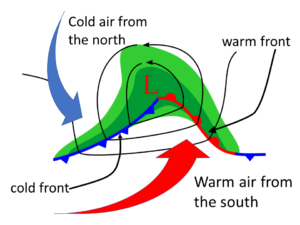The most common flow vis technique is to mark or ‘seed’ some of the fluid, while the rest remains transparent. The seed interacts with light while the transparent fluid does not- at least not as much (more on index of refraction techniques later). The boundary between the seeded and unseeded flow is then visible, so let’s call this a ‘boundary technique’. A slight variation is to mark two adjacent fluids differently, such as pouring two paints side by side.
Most of the transparent fluids are gases or gas mixtures like air, or liquids like water. Both air and water are made of relatively small molecules; that’s why they are transparent; they don’t interact with photons in the visible light spectrum very strongly.
The substance used for seeding can be categorized by size; let’s say molecule scale (< 1 nanometer) like dye molecules versus collections of molecules large enough to be called particles if solid, or aerosols if liquid, > 0.1 micrometer or 100 nanometers. The way each of these two categories works with fluids and with light is very different. Let’s start with molecules for seed or marker; then we’ll cover particles as seeding in air and water.

In liquids, specifically water, we would inject a ‘dye’ (NOT die). Dyes are usually large molecules with special chromophore groups stuck on . OK, that’s all the color chemistry we’ll do. Dyes are generally used in water (think food coloring) and are discussed below. Besides water, you might want to use an oil, maybe a vegetable oil as your transparent fluid. Recently, oil-based food dyes have become available, used in chocolate and candy, and they also work in vegetable oils but you’ll need to use a lot because they aren’t very concentrated. Beta carotene, derived from carrots, is supposed to be fat soluble, but the powdered form I tried was water soluble instead. There is also a fluorescent dye you can add to motor oil or refrigerants to help find leaks , as shown in Figure 1. There are oil or solvent based dyes used in histology and for dying leather , but these are toxic and/or highly flammable; not recommended for casual use.
You might be thinking ‘what about oil paints’? It turns out that oil paints have color because of pigments: finely ground solid particles mixed into linseed or other oils. Let’s delay discussion of paints to the particulate section.
I can’t think of any big molecules that could be used like a dye in air or other gases. Gases are just too low in density. Even a pure gas of dye molecules won’t interact with light enough to be visible in normal light; you’d need a focused laser beam. Instead particles and aerosols are used for boundary techniques in gases.
So here’s how this section on boundary techniques is organized
- Dye (Molecular) Techniques
- How to ensure the dye does NOT disturb the flow
- How to make the dye show up – to have HIGH VISIBILITY. We’ll have to talk about how light interacts with matter in general, and then how those interactions can be tweaked to make the best of our boundary techniques. We’ll come back to the light/matter physics a few more times later, in the context of other techniques.
- Glowing fluids: special techniques we can do with other molecular markers, specifically what happens with fluids that end up emitting light; still a boundary technique, but with flames!
- Particle Techniques
- Particle physics: flow and light
- Particles for seeding air
- Particles for seeding water
References:


